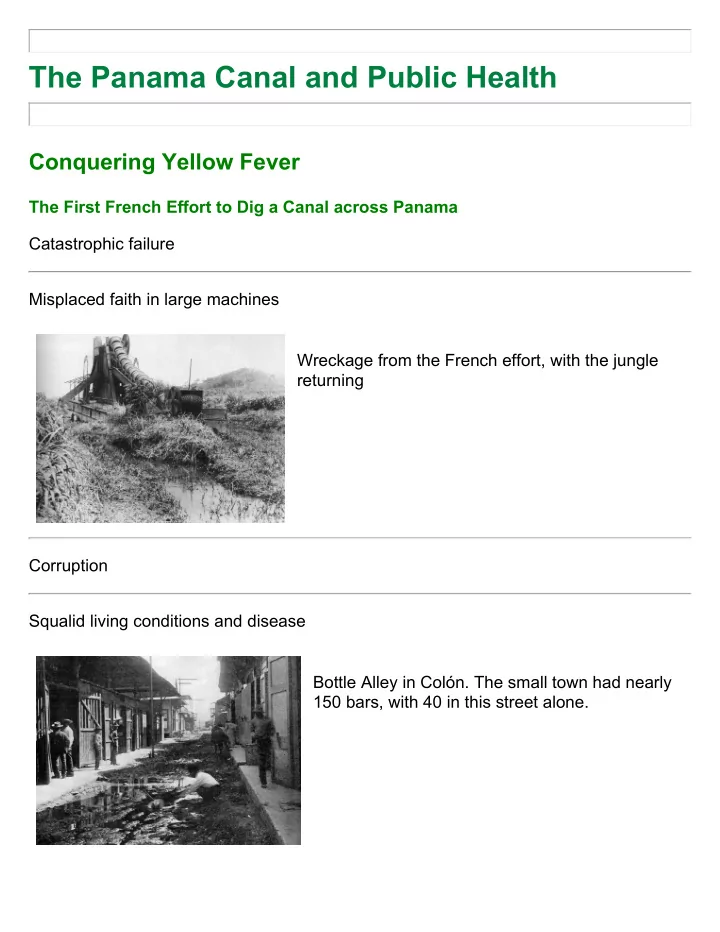

The Panama Canal and Public Health Conquering Yellow Fever The First French Effort to Dig a Canal across Panama Catastrophic failure Misplaced faith in large machines Wreckage from the French effort, with the jungle returning Corruption Squalid living conditions and disease Bottle Alley in Colón. The small town had nearly 150 bars, with 40 in this street alone.
Panama had: Yellow fever, malaria, bubonic plague, and typhoid Visitors to regions are less resistant to local pathogens During the 1850s, 22,000 people died, annually one third of the workforce was sick Disease was one of the main reasons why the French had to give up The American Effort Yellow fever A virus, a mild attack gave life-long immunity In places like Panama, the adults were immune, but not the visitors 1900 in Havana: Public health efforts led by Colonel William Crawford Gorgas Experiments showed that yellow fever spread, not through filth, rather mosquitoes Ades aegypti: the mosquito that transmits yellow fever Other experiments to confer immunity through controlled mosquito bites, killed people Successful Public Health Measures Yellow fever patients screened in Buildings fumigated Standing water drained or oil spread on the surface Same methods to be applied in Panama Hampered by political opposing From whom? why? Gorgas asked later why the demonstration in Cuba did not convince people?
President Theodore Roosevelt convinced by medical experts: "If you fall back upon the old methods of sanitation, you will fail, just as the French failed. If you back up Gorgas and let him pursue his campaign against the mosquitoes, you will get your canal. Fumigation Clearing building of people and pets, sealing them airtight with paper and wood framing, and burning an insecticide like pyrethrum or sulphur A fumigation squad, carrying ladders, paper, and paste, assembles in Panama City, 1905. Screening in infected people Tons of insecticide Whereas Ades aegypti had made up ten percent of the mosquitoes in Havana, the percentage was ninety in Panama All homes in Panama were fumigated three times Mosquito catchers Caught individual mosquitoes in test tubes and killed them with chloroform Ades aegypti was "domesticated" Preferred to live inside of homes and to lay eggs in clean, still water Panamanians depended on rain water for drinking water Standing water was cleaned up throughout the city In the hospitals, nurses had set bed legs in tins of water to stop ants
When the sewage and water systems were installed, many of the mosquito breeding places disappeared These public health measures were for the foreigners working on the canal, not the locals: why? Local adults had immunity Suffered these invasive procedures without seeing the need Malaria Malaria and yellow fever are both transmitted by mosquitoes, but are also different Malaria is a chronic, debilitating disease Spread by different mosquitoes Anopheles preferred swamps and forests Thus much more difficult to find and destroy Quinine existed as a drug against malaria, to remedy and resist infection Behavior of these mosquitoes studied Men lay on cots with pill boxes, as bait for mosquitoes, waiting to capture them Captured mosquitoes were dyed blue, then released Results: this mosquito disliked bright light and typically did not fly more than 200 yards Remedy: brush and grass were cut and standing water drained for that distance around inhabited areas "Clever": Water was set out to attract mosquitoes to lay their eggs, and was then dumped out Drainage ditches were dug to carry away standing water These had to be maintained
By 1906 the Canal Zone was safe enough for President Theodore Roosevelt to visit Roosevelt, here in a white suit, making a "Strenuous Exhibition" in Panama. The Workers A steamer carrying laborers from Barbados arrives in Colón. The tiny island provided the bulk of the thousands of workers for the American Panama Canal effort. Pneumonia was common among West Indian workers Poor standard of living One set of clothes, poor nutrition An official mess kitchen for the West Indian workers. No chairs or tables were provided, and the food was often inedible. After a short time, most workers made their own arrangements.
Accidental deaths Example: Hidden cache of dynamite exploded Killed two white engineers, and twenty-three black laborers A cemetery on photographed shortly after the completion of the canal. Gorgas What he would have done differently: Raise wages Combination of modern technology and old-fashioned labor Workers at the base of the lower gate of Gatún Locks. The final joining of the oceans being accomplished by pick-and-shovel men digging a channel.
Subsequent Effort to Rid the Southern US of Malaria Reluctance to follow the example of Panama: why? The U.S.S. Texas in Gatún Locks in July 1919.
Recommend
More recommend